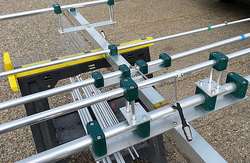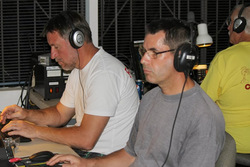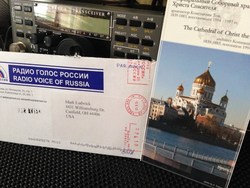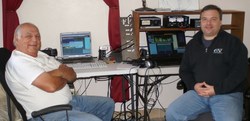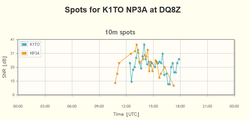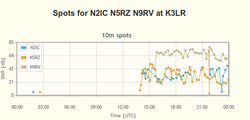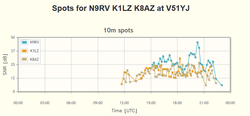 December 18, 2013 Editor: Ward Silver, NØAX | ||||||||||
IN THIS ISSUE
NEW HF OPERATORS - THINGS TO DO This coming Sunday's ARRL Rookie Roundup is designed to get you started on CW and you'll find lots of other newcomers trying out their keys. And, it's a great warmup for the annual Straight Key Night, whether you are an OT (Old Timer) or a Rookie. If you've ever wondered why DX contests aren't scored by distance, why not give the Stew Perry Topband Distance Challenge a try? That "temporary" antenna for the ARRL 160 Meter Contest is still up, isn't it? Of course it is! BULLETINS There are no bulletins in this issue. BUSTED QSOS Eric K9GY's photo in the previous issue was a "selfie" and not from N6AN say both of them. CONTEST SUMMARY Complete information for all contests follows the Conversation section December 21-22
December 28-29
A few weeks ago the team behind InnovAntennas acquired the legendary Force 12 antenna company and have moved the factory from Bridgeport, TX to Grand Junction, CO into a facility shared with InnovAntennas America. InnovAntennas Ltd in England is now manufacturing Force 12 products for the European market. The Grand Junction facility is in full swing and we are shipping building and shipping antennas. Watch for a complete update of the Force 12 website by the end of the year. Updated versions of classic Force 12 antennas as well as all-new models will be produced. Stay tuned! (Thanks, Bill AA7XT)
A company in England has produced a device that can shut down a car with pulses of RF. No word on the exact frequency range although it is said to be "a small radar transmitter." Could this be considered an "anti-rover"? Referees for the 2014 World Radiosport Team Championship have been selected and a list posted on the competition's home page! The selected referees come from all over the world and more than 30 countries, a tribute to the event's past and present organizers noted by Chief Judge, Dave Sumner, K1ZZ. During the competition, a referee will be on site at each of the 59 competing stations to verify compliance with the rules and make decisions on any rule questions by the teams. The referees must be top-level contesters because they must simultaneously listen to the audio from both operators for the entire 24 hours of the WRTC2014 competition. Managed by Dan Street, K1TO, the 143 applications received were evaluated according to many factors, including geographical areas, language skills and SO2R ability. WRTC2014 takes place in the Boston area on July 12-13, 2014. You may be interested in the results of the recent Jamboree on the Air and there is a full report and summary video on the JOTA website of K2BSA. Overall, the number of stations participating in the USA increased by 33% to 271. The number of Scouts reported on the air declined by 25% to just under 14,000. The number of stations that registered prior to the event hit a new record of 419, quite a few just didn't provide a report after the event. So the organizers expect that the number of Scouts actually continued to increase. (Thanks, National JOTA Organizer and Chairman National Radio Scouting Committee, Jim Wilson K5ND) There are special prizes for the upcoming World Wide Iron Ham Contest - winners in the Single-Op All-Band and Multi-Op categories will win a round trip to and accommodations at WRTC 2014! Sponsored by the Araucaria DX Group, the Iron Ham uses CW, Phone, and RTTY in a 24-hour format. (Thanks, Oms PY5EG) Another advance combining nanotechnology and graphene is expected to create antennas, albeit very tiny ones, that could operate on WLAN frequencies, enabling nano-scale devices to communicate with each other. The electromagnetic properties of graphene fibers are apparently quite different than metallic wires, leading to some interesting applications.
Is urban electro-smog getting you down by raising the noise floor up? Brian KDØTLO sent in this story of a truly quiet place in which the only acceptable RF emissions are from hams -- the National Radio Quiet Zone in Green Bank, West Virginia. It's quite a job keeping unwanted signals off the air, as we all know too well. You can learn more about ham radio and quiet zones on W3BE's blog, W3Beinformed. And speaking of listening really, really hard -- this story has the listening directed toward Earth instead of the usual other way 'round. It turns out that yes, the Juno spacecraft did hear ham signals during its October flyby on the way to Jupiter. You can see more in this video from NASA as hams turn the table on a satellite, sending HI spaceward rather than listening for HI from on high. (Thanks, Don NK6A) Getting those operating events on the refrigerator in advance is crucial to a successful-not-stressful contest season, but what if the paper calendar has been replaced by an online version? This Instructables project shows how to use a Raspberry Pi computer module to control a wall-mounted Google Calendar that will never go out of date! Steve VE7SL reports that, "After building similar stations over the past few months, myself and Markus VE7CA completed our first lightwave contact on 655 nm yesterday evening just shortly after sunset. Both systems use a single Luxeon heat-sinked LED (Deep Red)." Both systems used about 1 watt of input power and inexpensive plastic Fresnel lenses. BPW32 lensless PIN diodes were used as the detectors. The path was about 34 miles across the Georgia Straight between West Vancouver and Mayne Island. "All in all, great fun!" says Steve - VHF+ contesters take note! The Contest Club of Finland (CCF), OH DX Foundation (OHDXF), and Estonian Radio Amateur Union (ERAà °) invite everyone to the traditional Contest/DX Meeting that will be held this year in Tallinn, Estonia instead of on a Finland-to-Sweden cruise ship as usual. In addition to an interesting agenda and meeting a lot of friends you are also invited to visit ES5TV/ES9C contest station on Sunday. (Thanks, Tonno ES5TV) Three great stories can be found in the December 2013 issue of the Potomac Valley Radio Club newsletter. First is an explanation by Pete N4ZR of the beta version of AR Cluster Version 6, the first DX cluster node software to incorporate user-configurable RBN spot quality filtering. Next comes a story about the Deutsches Museum exhibit on the history of radio by Eric W3DQ. Finally, if you've wondered about who W4KFC was and why he holds such status in the world of contesting, Pip WB4FDT recounts some of the highlights of Vic's ham radio career. Good reading! Here's something interesting in the world of digital ham radio - a D-STAR Ham Access Point, D-HAP! In the words of its creators, "We combined a Raspberry Pi, a DVAP Dongle, WiFi, a USB power supply, a whole bunch of connectors, almost 2 hours of CNC time, and about 3 hours on the bench. Then we squished until it was about the size of a book." Squished! (Thanks, Ray N9JA)
The Voice of Russia, formerly known as Radio Moscow during the USSR era, will cease shortwave broadcasts as of January 1, 2014. From the 1950s through the 1980s, the station, as Radio Moscow, was a virtual beacon for short-wave listeners (SWLs), many of whom gravitated into amateur radio. Voice of Russia currently broadcasts to 160 countries in 38 languages for 151 hours per day on short and medium waves, on FM, via satellite, and via the Internet. Earlier this year shortwave transmissions were cut to 26 hours a day in all languages, down from more than 50 hours a day in 2012 VOR, which claims to be the first radio station to broadcast internationally, will continue to broadcast online and via three medium-wave transmitters. (Thanks, John K1AR) "2014 will be a GREAT year for Contest University (CTU)!" says CTU President, Tim K3LR. "In the USA for the first time - there will be two different Contest University all-day sessions during 2014...with no overlap or repeated papers. The first USA CTU will be the Dayton Contest University on Thursday May 15, 2014 at the Crowne Plaza Hotel. Space at CTU USA Dayton will be limited - and Crowne Plaza hotel rooms are already fully booked. The second USA CTU will be held at the historic 2014 ARRL National Centennial Convention in Hartford, CT on July 17, 2014. The CTU Centennial will be an all-day event with six CTU presentations in one class room. Registration for the ARRL Centennial CTU will be handled through the ARRL. It can be confusing trying to setup and operate a multi-single category with the subtle differences in rules between the CQ World Wide and ARRL DX Contests. Here is an article about multi-single stations in both contests. Going on this month and ending on the last day of the year, RAEM Activity Days celebrate the 110th Anniversary of the birth of Ernst Krenkel, a legendary polar radio operator, the first President of the Federation of Radio Sport of the USSR, and a Hero of the Soviet Union. Numerous Russian stations with special calls are active until 2359Z on December 31st. (Thanks, Daily DX) Web Site of the Week - A good three-part series on the Internet and ham radio has been published by EDN's "A Ham's Eye View" blogger and contester, Doug K1DG. Part 1 introduces the relationship. Remote operation is covered in Part 2 and Part 3 gets into Internet-ham radio "parallel universes." WORD TO THE WISE Why contest? Anthony AB9YC says, "I'm looking forward to my next a-ha moment when I can smile, and say to myself, "I am getting this!" Dick K4XU sent a link to this video in which he is demonstrating a new MicroSemi 1200-watt amplifier module. These devices are the active ingredient in the Elecraft KPA500 and the new THP 2.5K amplifier.
The webinar on station improvement by Hank W6SX, has been posted to the WWROF website where you can find it via the Webinars link. Hank's presentation is of particular interest to "Little Pistols" and those who are space limited. He has added a link to the elevation plot and for locating the Ladder Snaps in the presentation. (Thanks, Ken K4ZW) If you have new Technician licensees in your club or shack, here's a full-color band chart for Techs published by the ARRL. Provisional results for the October 2013 School Club Roundup have been published on the new results web page created by WA7BNM. The soapbox comments are great, particularly the characterization of contesting as "speed dating" by the NQ9P team. February's SCR is a great opportunity for individuals and clubs to bring radiosport to students. Thanks also to the SCR sponsor, the Long Island Mobile Amateur Radio Club.
Now that all log submission deadlines have passed, you can see all of the Raw Scores for the CQ Worldwide SSB and CW Contests. These scores are computed from the submitted logs before log-checking. If you notice any problems, contact the contest manager. Final scores for the 2013 Missouri QSO Party have been released by the sponsors, the Boeing Employees Amateur Radio Society (BEARS). Claimed Scores for the 2013 Ukrainian DX Contest are also available online. (Thanks, Leo UT7CL) Contest managers - please drop the editor a note to let the readers know when your results are published! OPERATING TIP With RTTY contesting increasing in popularity and the ARRL's RTTY Roundup coming up in January, one of the premier RTTY contesters, Don AA5AU, has written several tutorials to help you to get started such as this one, primarily aimed at Writelog users, but that can be applied to most logging software and a more generic MMTTY tutorial. N1MM-specific information for MMTTY and an overall N1MM digital operation setup guide is also available. Jim AD4EB has also written a guide to the basics you can find on the Tennessee Contest Group website. When you're finally all set up and ready for the contest, AA5AU has a set of suggested exchange messages for NAQP written for Writelog but easily convertible to N1MM or other software. (Thanks, Chad WE9V) Being intrepid homebrewers and experimenters, George N2APB and Joe N2CX are always on the lookout for simple measurement equipment that can be used on our benches. Several months ago N5IB and W5JH teamed up develop the Poor Ham's Scalar Network Analyzer, a useful-and-inexpensive way to sweep an RF signal through a Device-Under-Test (DUT) and read and plot the power coming back from the DUT. The discussion (among many others) is available on the Chat With the Designers website as episode #66 from December 10th. Trying to dissolve the "junk" between sections of telescoping aluminum tubing can certainly try one's patience! Patrick NJ5G suggests a method of keeping the joint immersed in the solvent or penetrating solution without having to stand there and watch it! "Stand the tubes vertically with the smaller diameter tube on top. Form a lump of modeling clay around the larger diameter tube just below the overlap point. Now you can pour in your favorite solvent and immerse the joint. If your favorite solvent dissolves the modeling clay then use silicone caulk instead of clay." He notes that heating and or cooling the joint may help, as well.
What is a good cable to use for full-power coax jumpers in the station? RG-213 cable can be awfully stiff and unwieldy so Jeff N5TJ recommends RG-142, a Teflon-insulated equivalent of RG-58 cable. He notes that it is "great to solder and won't melt!" Have you wondered about the RF characteristics of the one-sided Möbius strip? In this Microwave Journal article from the November 2013 issue, Drs Ulrich Rohde (N1UL), Poddar, and Sundararajan tackle the math in the article "Printed Resonators: Möbius Strip Theory and Applications." Brian K1LI reports that W6PQL has also designed an amplifier controller board with similar functions to those on the VK4DD board mentioned in the previous issue. Five more useful projects, this time for the workbench appeared in the stream of ideas from the Instructables website:
And if you would like to do some science and don't mind building your own equipment, here is a great source of information about that from Tom K1KI. Why do commercial amplifiers often use several smaller value capacitors in parallel instead of one larger cap? Ian, GM3SEK responds that "The main reason for using smaller values is to share out the RF current between several capacitors. As the heat losses and temperature rise are proportional to I-squared, using two capacitors of half the original value will reduce the drift by a factor of 4, or three capacitors will reduce it by a factor of 9. However, it is also important to use capacitors with a low temperature coefficient (NP0 ceramic caps or large silver micas) and it's true that these are more easily obtainable in smaller capacitance values." Morel 4X1AD also notes that two small ceramic HV caps are usually much cheaper than one high current ceramic cap as was used in the past. Todd N4JRZ contributes this reference to a website that explains how to convert a Cushcraft A3 tribander Yagi to cover 12 meters and 17 meters. Not a bad project for an older antenna looking for a new job! While preparing to make a group purchase for several local clubs, Jim K9YC discovered that Fair-Rite now makes a 1.4-inch ID #31 clamp-on (part number 2631181381). It's 2.5 inches long, and is the equivalent of five of the 1.4-inch ID, 2.4-inch OD #31 toroids. The big clamp-on is available for less than half the cost of the equivalent five toroids! The clamp-on core is large enough to hold 7 turns of RG8/RG213-size coax without removing the connector, as well. Technical Web Site of the Week - Frank W3LPL recommends the Pyle PHE300 2-Channel Hum/Noise Destroyer as an inexpensive and extremely effective solution to sound card-related hum and noise problems. He notes, that it's "so inexpensive it isn't worth the time and effort to build your own transformer isolation box." Another option is using optoisolators and Craig K9CT recommends the optically-isolated FSK keying interface made by W3YY. This is a generic board and can be used for lots of applications in which a simple isolated signal path is required. New Science When the CW Skimmer software was released by Alex VE3NEA, I remember thinking it had the potential to be a game-changer. As it turns out, "skimmers" are changing the game but in more ways than we had anticipated and in more games than we expected.
The most obvious change was simply the sheer speed advantage that it conferred compared to human operator. Even giving the human operator the best possible outcome in every situation, assuming perfect timing sync as a new signal was tuned in, and so forth, CW Skimmer could extract call signs from 100 kHz of band about 15 times faster. But that was thinking too small, only considering the software as an accessory for one operator. The Reverse Beacon Net started out as a way for individual stations to see how they were being heard there instead of what they could hear here. Novel, indeed, but not really all that different from a regular QSO except that the RBN can give you real signal reports with resolution of 1 dB. As more and more skimmers are added to the network, something very interesting has begun to happen.
Multiple CW Skimmer stations around the world are now working together, listening to all the bands, all the time - 24/7/365. There are currently a few dozen around the world, mostly in North America and Europe but more are being added all the time and all continents are represented. While not calibrated to the accuracy of a laboratory instrument in most cases, we are now watching a worldwide propagation monitoring network come to life! In a couple of years, no matter where you are, one or two CQs or TEST transmissions will generate a snapshot of propagation from your location to every populated region on the planet...in about 10 seconds. This is simply unprecedented - consider the effects on just two areas of amateur technology. First and most obviously, propagation can now be assessed in real-time to a degree completely unavailable before. Furthermore, the data is logged and available for analysis. This forms a crucial and previously-missing link between propagation models and propagation as it actually occurs. To be sure, HF propagation testing was done many years ago in academia and by the military but the breadth and depth of the RBN data is completely new. For example, in the K1TO-NP3A chart you can clearly see the 10 meter band opening to Europe from the two different areas as the world turns. Coupled with validated QSO databases such as public contest logs and solar-geomagnetic data from NOAA databases, amateurs can begin to look for "interesting" propagation that models miss. Other propagation assessment tools, like K1JT's WSPR protocol and its companion network, WSPRNet, can be added to the mix. Perhaps someday, data from Logbook Of the World - the world's largest database of validated point to point communications data - will be available, as well.
Another great use of automated reception reports is in antenna and antenna system design. No longer limited to test range data (at best), hams can now ask and answer questions such as, "What is the right height for my antenna for the path to..." and "Does my new design perform better or worse than..." and a million other questions for which answers are rarely precise and usually completely unavailable. Who can look at the comparisons and not be struck by the different signal levels of the stations? We have been given a gift, the power of which we are just beginning to sense. When new types of data become available for analysis and are combined with new forms of visualization, we know that good things happen. Unexpected things. Explanations of mysteries. Better still, new explanations for what we thought we understood. Best of all, we will ask new questions! The world of Amateur Radio is changing, in part due to these new tools. I look forward to new science being "done" by amateurs, resulting in new understandings of the world in which live and an exciting future. 18 December through 31 December 2013 An expanded, downloadable version of QST's Contest Corral in PDF format is available. Check the sponsor's Web site for information on operating time restrictions and other instructions. HF CONTESTS NAQCC Milliwatt Sprint--CW, from Dec 18, 0130Z to Dec 18, 0330Z. Bands (MHz): 3.5-14. Exchange: RST, S/P/C, and NAQCC mbr nr or power. Logs due: 4 days. Rules Russian 160 Meter Contest--Phone,CW, from Dec 19, 2100Z to Dec 19, 2300Z. Bands (MHz): 1.8. Exchange: RS(T), serial, square ID (see website). Logs due: Jan 20. Rules Lighthouse Christmas Lights QSO Party--Phone,CW,Digital, from Dec 20, 0001Z to Jan 1, 2359Z. Bands (MHz): 1.8-28, 50,144. Exchange: Serial or ARLHS number. Logs due: Jan 31. Rules Feld-Hell Rudolph Hell Sprint--Digital, from Dec 21, 0000Z to Dec 21, 2400Z. Bands (MHz): 3.5-28. Monthly on 3rd Saturday. Exchange: RST, S/P/C, Feld-Hell member nr. Logs due: 7 days. Rules OK DX RTTY Contest--Digital, from Dec 21, 0000Z to Dec 22, 2400Z. Bands (MHz): 3.5-28. Exchange: RST and CQ Zone. Logs due: Jan 15. Rules Croatian CW Contest--CW, from Dec 21, 1400Z to Dec 22, 1400Z. Bands (MHz): 1.8-28. Exchange: RST and serial. Logs due: 30 days. Rules ARRL Rookie Roundup--CW, from Dec 22, 1800Z to Dec 22, 2359Z. Bands (MHz): 3.5-28. Exchange: Both calls, name, check, S/P/XE or "DX". Logs due: See web. Rules SKCC Straight Key Sprint--CW, from Dec 26, 0000Z to Dec 26, 0200Z. Bands (MHz): 1.8-28, 50, Monthly on the 4th Wednesday UTC. Exchange: RST, S/P/C, name, SKCC nr or power. Logs due: 5 days. Rules DARC XMAS Contest--Phone,CW, from Dec 26, 0830Z to Dec 26, 1059Z. Bands (MHz): 3.5-7. Exchange: RS(T) and DOK or special station code. Logs due: 3 weeks. Rules RAC Winter Contest--Phone,CW, from Dec 28, 0000Z to Dec 28, 2359Z. Bands (MHz): 1.8-28, 50,144. Exchange: RS(T) and province or serial. Logs due: Jan 31. Rules Iron Ham Contest--Phone,CW,Digital, from Dec 28, 1200Z to Dec 29, 1159Z. Bands (MHz): 3.5-28. Exchange: RS(T) and CQ zone. Logs due: 3 days. Rules Stew Perry Top Band Distance Challenge--CW, from Dec 28, 1500Z to Dec 29, 1500Z. Bands (MHz): 1.8. Exchange: 4-char grid square. Logs due: 30 days. Rules RAEM Contest--CW, from Dec 29, 0000Z to Dec 29, 1200Z. Bands (MHz): 3.5-28. Exchange: Serial and lat/long in degrees. Logs due: Jan 25. Rules ARRL Straight Key Night--CW, from Jan 1, 0000Z to Jan 1, 2400Z. Bands (MHz): 3.5-28, 50+. Exchange: General QSO information. Logs due: Jan 31. Rules VHF+ CONTESTS ARRL Straight Key Night--CW, from Jan 1, 0000Z to Jan 1, 2400Z. Bands (MHz): 3.5-28, 50+. Exchange: General QSO information. Logs due: Jan 31. Rules Lighthouse Christmas Lights QSO Party--Phone,CW,Digital, from Dec 20, 0001Z to Jan 1, 2359Z. Bands (MHz): 1.8-28, 50,144. Exchange: Serial or ARLHS number. Logs due: Jan 31. Rules SKCC Straight Key Sprint--CW, from Dec 26, 0000Z to Dec 26, 0200Z. Bands (MHz): 1.8-28, 50, Monthly on the 4th Wednesday UTC. Exchange: RST, S/P/C, name, SKCC nr or power. Logs due: 5 days. Rules RAC Winter Contest--Phone,CW, from Dec 28, 0000Z to Dec 28, 2359Z. Bands (MHz): 1.8-28, 50,144. Exchange: RS(T) and province or serial. Logs due: Jan 31. Rules LOG DUE DATES 18 December through 31 December
ARRL Information Click here to advertise in this newsletter, space subject to availability. Your One-Stop Resource for Amateur Radio News and Information ARRL membership includes QST, Amateur Radio's most popular and informative journal, delivered to your mailbox each month. Subscribe to NCJ - the National Contest Journal. Published bimonthly, features articles by top contesters, letters, hints, statistics, scores, NA Sprint and QSO Parties. Subscribe to QEX - A Forum for Communications Experimenters. Published bimonthly, features technical articles, construction projects, columns and other items of interest to radio amateurs and communications professionals. Free of charge to ARRL members: Subscribe to The ARRL Letter (weekly digest of news and information), the ARES E-Letter (monthly public service and emergency communications news), Division and Section news -- and much more! ARRL offers a wide array of products to enhance your enjoyment of Amateur Radio. Visit the site often for new publications, specials and sales. Donate to the fund of your choice -- support programs not funded by member dues! Reprint permission can be obtained by sending email to permission@arrl.org with a description of the material and the reprint publication. ACKNOWLEDGEMENTS ARRL Contest Update wishes to acknowledge information from WA7BNM's Contest Calendar and SM3CER's Contest Calendar. | ||||||||||
